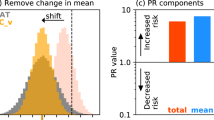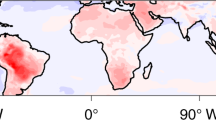Abstract
Theoretical models predict that, in the absence of moisture limitation, extreme precipitation intensity could exponentially increase with temperatures at a rate determined by the Clausius–Clapeyron (C–C) relationship1,2. Climate models project a continuous increase of precipitation extremes for the twenty-first century over most of the globe3,4,5. However, some station observations suggest a negative scaling of extreme precipitation with very high temperatures6,7,8,9, raising doubts about future increase of precipitation extremes. Here we show for the present-day climate over most of the globe, the curve relating daily precipitation extremes with local temperatures has a peak structure, increasing as expected at the low–medium range of temperature variations but decreasing at high temperatures. However, this peak-shaped relationship does not imply a potential upper limit for future precipitation extremes. Climate models project both the peak of extreme precipitation and the temperature at which it peaks (Tpeak) will increase with warming; the two increases generally conform to the C–C scaling rate in mid- and high-latitudes, and to a super C–C scaling in most of the tropics. Because projected increases of local mean temperature (Tmean) far exceed projected increases of Tpeak over land, the conventional approach of relating extreme precipitation to Tmean produces a misleading sub-C–C scaling rate.
This is a preview of subscription content, access via your institution
Access options
Access Nature and 54 other Nature Portfolio journals
Get Nature+, our best-value online-access subscription
$29.99 / 30 days
cancel any time
Subscribe to this journal
Receive 12 print issues and online access
$209.00 per year
only $17.42 per issue
Buy this article
- Purchase on Springer Link
- Instant access to full article PDF
Prices may be subject to local taxes which are calculated during checkout





Similar content being viewed by others
References
Trenberth, K. Conceptual framework for changes of extremes of the hydrologic cycle with climate change. Climatic Change 42, 327–339 (1999).
Trenberth, K., Dai, A., Rasmsussen, R. & Parsons, D. The changing character of precipitation. Bull. Am. Meteorol. Soc. 84, 1205–1217 (2003).
Tebaldi, C., Hayhoe, K., Arblaster, J. & Meehl, G. Going to the extremes. Climatic Change 79, 185–211 (2006).
Kharin, V. V. et al. Changes in temperature and precipitation extremes in the IPCC ensemble of global coupled model simulations. J. Clim. 20, 1419–1444 (2007).
Kharin, V. V., Zwiers, F. W., Zhang, X. & Wehner, M. Changes in the temperature and precipitation extremes in the CMIP5 ensemble. Climatic Change 119, 345–357 (2013).
Berg, P. et al. Seasonal characteristics of the relationship between daily precipitation intensity and surface temperature. J. Geophys. Res. 114, D18102 (2009).
Hardwick Jones, R. et al. Observed relationships between extreme sub-daily precipitation, surface temperature, and relative humidity. Geophys. Res. Lett. 37, L22805 (2010).
Utsumi, N. et al. Does higher surface temperature intensify extreme precipitation? Geophys. Res. Lett. 38, L16708 (2011).
Maeda, E. E. et al. Decreasing precipitation extremes at higher temperatures in tropical regions. Nat. Hazards 64, 935–941 (2012).
Hegerl, G. E. et al. Challenges in quantifying changes in the global water cycle. Bull. Am. Meteorol. Soc. 96, 1097–1115 (2015).
Groisman, P. et al. Trends in intense precipitation in the climate record. J. Clim. 18, 1326–1350 (2005).
Fischer, E. M. & Kutti, R. Observed heavy precipitation increase confirms theory and early models. Nat. Clim. Change 6, 986–991 (2016).
Huntington, T. G., Richardson, A. D., McGuire, K. J. & Hayhoe, K. Review: climate and hydrological changes in the northeastern United States: recent trends and implications for forested and aquatic ecosystems. Can. J. Forest Res. 39, 199–212 (2009).
Easterling, D. R. et al. Climate extremes: observations, modeling and impacts. Science 289, 2068–2074 (2000).
Allan, R. & Soden, B. Atmospheric warming and amplification of precipitation extremes. Science 321, 1481–1484 (2008).
Ahmed, K. F. et al. Statistical downscaling and bias correction of climate model outputs for climate change impact assessment in the U.S. Northeast. Glob. Planet. Change 100, 320–332 (2013).
Parr, D. T., Wang, G. L. & Bjerklie, D. Integrating remote sensing data on evapotranspiration and leaf area index with hydrological modeling: impacts on model performance and future predictions. J. Hydrometeorol. 16, 2086–2100 (2015).
O’Gorman, P. A. Precipitation extremes under climate change. Curr. Clim. Change Rep. 1, 49–59 (2015).
Lenderink, G. et al. Scaling and trends of hourly precipitation extremes in two different climate zones—Hong Kong and the Netherlands. Hydro. Earth Syst. Sci. 15, 3033–3041 (2011).
Lenderink, G. & van Meijgaard, E. Increase in hourly precipitation extremes beyond expectations from temperature changes. Nat. Geosci. 1, 511–514 (2008).
Shaw, S. B. et al. The relationship between extreme hourly precipitation and surface temperature in different hydroclimatic regions of the United States. J. Hydrometeorol. 12, 319–325 (2011).
Mishra, V. et al. Relationship between hourly extreme precipitation and local air temperature in the United States. Geophys. Res. Lett. 39, L16403 (2012).
Boucher, O. et al. in Climate Change 2013: The Physical Science Basis (eds Stocker, T. F. et al.) 571–657 (IPCC, Cambridge Univ. Press, 2013).
Seager, R., Naik, N. & Vecchi, G. A. Thermodynamic and dynamic mechanisms for large-scale changes in the hydrological cycle in response to global warming. J. Clim. 23, 4651–4668 (2010).
Ban, N., Schmidli, J. & Schär, C. Heavy precipitation in a changing climate: does short-term summer precipitation increase faster? Geophys. Res. Lett. 42, 1165–1172 (2015).
Chan, S. C. et al. Downturn in scaling of UK extreme rainfall with temperature for future hottest days. Nat. Geosci. 9, 24–28 (2016).
Christensen, J. H. et al. in Climate Change 2013: The Physical Science Basis (ed. Stocker, T. F.) 1217–1308 (IPCC, Cambridge Univ. Press, 2013).
O’Gorman, P. A. Sensitivity of tropical precipitation extremes to climate change. Nat. Geosci. 5, 697–700 (2012).
O’Gorman, P. A. & Schneider, T. The physical basis for increases in precipitation extremes in simulations of 21st-century climate change. Proc. Natl Acad. Sci. USA 106, 14773–14777 (2009).
Sherwood, S. & Fu, Q. A drier future? Science 343, 737–739 (2014).
Dee, D. P. et al. The ERA-Interim reanalysis: configuration and performance of the data assimilation system. Q. J. R. Meteorol. Soc. 137, 553–597 (2011).
Bosilovich, M. et al. MERRA-2: Initial Evaluation of the Climate NASA/TM–2015-104606 Vol. 43 (NASA GSFC, 2015).
Reichle, R. H. & Liu, Q. Observation-Corrected Precipitation Estimates in GEOS-5 NASA/TM–2014-104606 Vol. 35 (NASA GSFC, 2014).
Lorenz, D. J. & DeWeaver, E. T. The response of the extratropical hydrological cycle to global warming. J. Clim. 20, 3470–3484 (2007).
Schär, C. et al. Percentile indices for assessing changes in heavy precipitation events. Climatic Change 137, 201–216 (2016).
Acknowledgements
This study was supported by funding from the US National Science Foundation to G.W. (AGS-1063986, AGS-1659953). D.W. was supported by funding from the National Natural Science Foundation of China (Grant No. 51379224). K.E.T. is partially sponsored by DOE grant DE-SC0012711 and NCAR is sponsored by the National Science Foundation. We acknowledge the World Climate Research Programme’s Working Group on Coupled Modelling, which is responsible for CMIP. We also thank the climate modelling groups for producing and making their model output available. For CMIP the US Department of Energy’s Program for Climate Diagnosis and Intercomparison provides coordinating support and led development of software infrastructure in partnership with the Global Organization for Earth System Science Portals.
Author information
Authors and Affiliations
Contributions
G.W. and D.W. motivated the study; G.W. designed the study and conducted data analysis with input from K.E.T., M.G.B. and D.W.; G.W. and K.E.T. wrote the paper; A.E., D.T.P., D.W. and M.Y. all contributed to data processing.
Corresponding authors
Ethics declarations
Competing interests
The authors declare no competing financial interests.
Supplementary information
Supplementary Information
Supplementary Information (PDF 21630 kb)
Rights and permissions
About this article
Cite this article
Wang, G., Wang, D., Trenberth, K. et al. The peak structure and future changes of the relationships between extreme precipitation and temperature. Nature Clim Change 7, 268–274 (2017). https://doi.org/10.1038/nclimate3239
Received:
Accepted:
Published:
Issue Date:
DOI: https://doi.org/10.1038/nclimate3239
This article is cited by
-
Unveiling the dynamics of sequential extreme precipitation-heatwave compounds in China
npj Climate and Atmospheric Science (2024)
-
Climate change unevenly affects the dependence of multiple climate-related hazards in China
npj Climate and Atmospheric Science (2024)
-
Trends in seasonal precipitation extremes and associated temperatures along continental Chile
Climate Dynamics (2024)
-
Climate and water balance influence on agricultural productivity over the Northeast Brazil
Theoretical and Applied Climatology (2024)
-
Detection, mapping, and interpretation of the main drivers of the Arctic GPP change from 2001 to 2019
Climate Dynamics (2024)



